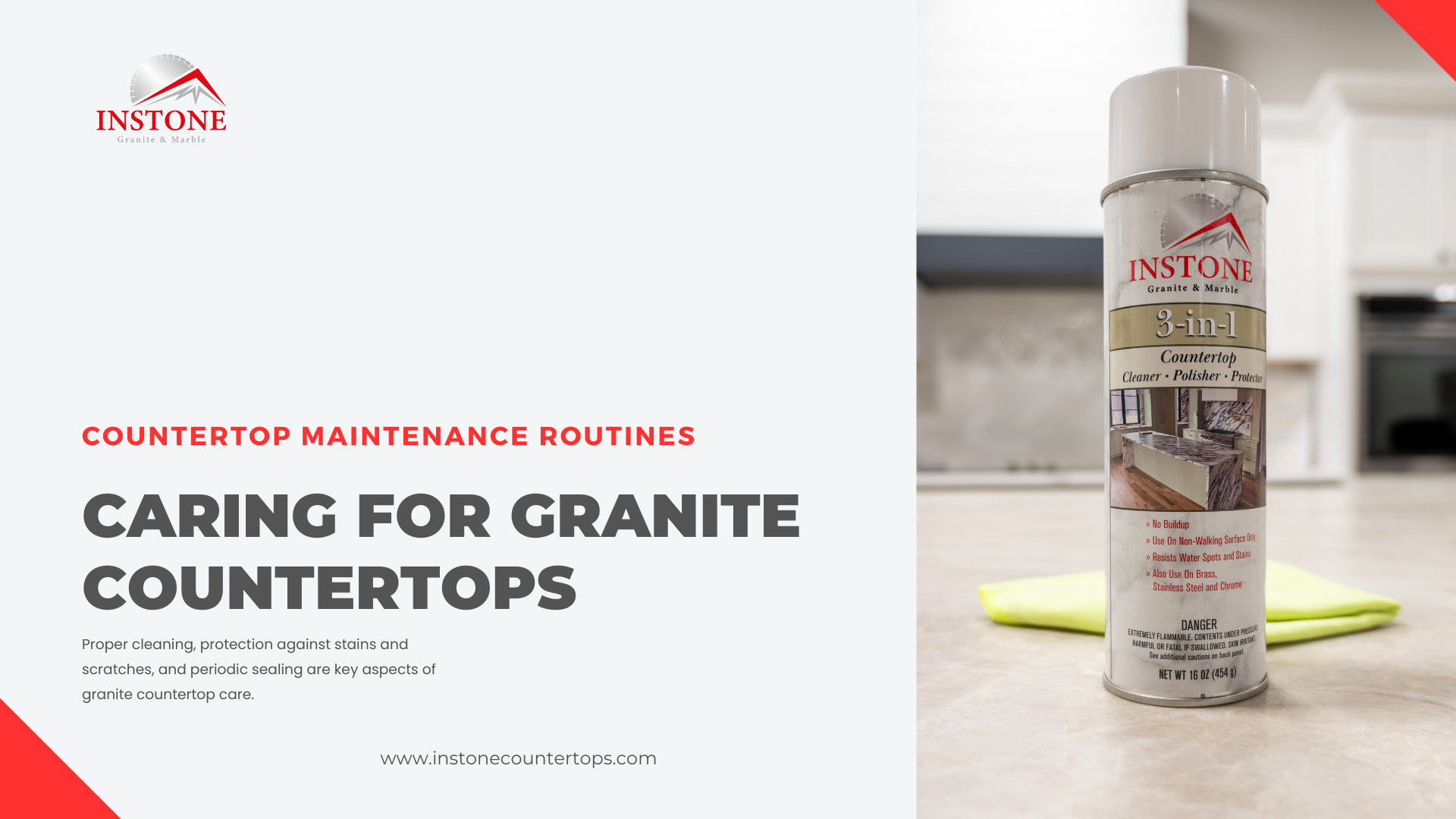Caring for Granite Countertops

Caring for granite countertops is essential for maintaining their beauty and durability. Granite, a natural stone, is popular in kitchens and bathrooms for its unique patterns and robust nature. However, it requires specific maintenance to keep it looking its best. Proper cleaning, protection against stains and scratches, and periodic sealing are key aspects of granite countertop care.
Granite Countertop Maintenance Routines
Maintaining granite countertops requires a routine approach to ensure they remain in top condition. Daily cleaning is fundamental to this process. The use of a soft cloth or a microfiber towel along with a mild detergent or a pH-neutral soap is recommended. This gentle cleaning helps in removing daily grime and spills without harming the granite’s surface. It’s crucial to avoid harsh chemicals, acidic cleaners, or abrasive cleaning tools, as these can etch or scratch the granite, diminishing its natural shine and smooth texture. Regular cleaning not only preserves the countertop’s appearance but also prolongs its life, preventing the need for more extensive repairs or treatments down the line.
Do Not Leave Spills Sitting
To care for granite countertops, promptly address spills, especially acidic ones like wine or citrus juices, to prevent etching and staining. Blot spills with a soft cloth without rubbing, then clean the area with a mild, pH-neutral detergent. Rinse thoroughly and dry with a soft cloth to maintain the granite’s appearance and integrity. Regularly following these steps will keep your countertops looking vibrant and unblemished.
Polishing
Polishing granite countertops is vital for maintaining their luster and durability. Over time, granite may dull, but regular polishing with a product designed specifically for granite can restore its shine and provide a protective layer against stains and scratches. Apply polish with a soft cloth using circular motions and then buff it dry. This not only enhances the appearance but also protects the surface, making cleaning easier. The frequency of polishing varies with use; countertops in high-use areas like kitchens may require more frequent polishing. Regular polishing ensures granite countertops remain beautiful and functional for years to come.
How Do You Remove Stains from a Granite Countertop?
Stains on granite countertops require prompt and appropriate treatment to avoid permanent damage.
How to Remove Water-Based Stains
To remove water-based stains like tea or coffee from granite countertops, make a thick paste of baking soda and water. Apply it over the stain and cover it with plastic wrap, sealing the edges with tape. Leave it overnight to let the baking soda absorb the stain. The next day, remove the wrap and wipe away the paste with a damp cloth. This method lifts stains without damaging the granite and avoids harsh chemicals. Regular cleaning and prompt spill management can prevent most stains, but this baking soda technique is a good solution for accidents. When it comes to quartz countertops, consult a professional quartz countertops installer for care and maintenance advice tailored to this specific material.
How to Remove Oil-Based Stains
To remove oil-based stains like grease or cosmetics from granite countertops, create a paste using baking soda and either water or hydrogen peroxide. Apply the paste over the stain and cover it with plastic wrap for several hours or overnight. This allows the paste to penetrate the granite and absorb the oil. Afterwards, remove the plastic wrap and wipe off the paste with a damp cloth. This method effectively reduces or eliminates oil-based stains, restoring the granite’s natural look. Always test the solution on a small, hidden area first to ensure it doesn’t affect the granite’s color or finish.
When to Seal Granite & Natural Stone
The frequency of sealing granite and natural stone countertops largely depends on the level of use and the specific type of stone. Heavily used areas like kitchen counters or high-traffic bathroom vanities may require more frequent sealing, perhaps every six months, to ensure optimal protection against stains and wear. Additionally, some granites are more porous than others and might absorb liquids more easily, necessitating more frequent sealing. It’s important to regularly check the effectiveness of the sealant by dripping water on the surface; if it beads up, the seal is intact, but if it soaks in, it’s time to reseal. Regular sealing maintains the stone’s resilience and preserves its aesthetic appeal, making it a crucial part of granite and natural stone maintenance. When considering quartz countertops, consult a professional countertop services provider to ensure proper care and maintenance, including sealing if necessary.
How Do You Seal a Granite Countertop?
Sealing a granite countertop is an essential step in maintaining its beauty and durability. Granite, a natural stone, is porous and can absorb spills and stains if not properly sealed. Over time, unsealed granite can become dull and lose its luster. Fortunately, sealing granite is a straightforward process that can be done by most homeowners with a few simple tools and materials. However, for those who prefer a professional touch or are unsure about the process, hiring professionals is always an option. They have the expertise and equipment to ensure that the sealing is done efficiently and effectively, guaranteeing a longer lifespan and improved appearance for your granite countertops. When seeking professional assistance, consider searching for countertop installers near me to find experts who can provide quality service.
Find Your Sealer
When selecting a sealer for your granite countertop, it’s important to choose one that is specifically designed for use on granite. These sealers are formulated to penetrate and protect the stone without damaging it. They vary in terms of their composition – some are water-based while others are solvent-based – and each type has its own advantages. Water-based sealers are generally more environmentally friendly and have less odor, while solvent-based sealers may offer a deeper penetration into the stone. It’s also important to consider the finish you desire, as some sealers can enhance the color of your granite, while others provide a more natural, invisible finish. Always read the product descriptions and reviews to ensure compatibility with your specific type of granite.
Clear and Clean the Countertop
Before sealing, it is crucial to thoroughly clean the granite countertop. This means removing any dirt, grime, and spills, as any residue left on the stone can get trapped under the sealer, affecting its appearance and effectiveness. Use a gentle cleaner suitable for granite; avoid harsh chemicals or abrasive scrubbers that can damage the stone’s surface. After cleaning, the countertop must be completely dried as moisture can interfere with the sealing process. This step might involve wiping the surface with a dry cloth and then allowing some time for any remaining moisture to evaporate naturally.
Ventilate the Area
Proper ventilation is key during the sealing process. Granite sealers, especially solvent-based ones, can emit strong fumes that are potentially harmful if inhaled in a closed environment. Open windows and doors or use fans to ensure a good flow of fresh air through the area. This not only protects your health but also aids in the drying process of the sealer. If you’re particularly sensitive to chemical smells, consider wearing a mask for additional protection. Remember, the goal is to create a safe and comfortable environment for this home maintenance task.
Apply the Sealer
When applying the sealer, use a soft cloth or a non-abrasive brush to spread it evenly over the surface of the granite. Ensure that you cover the entire area, including edges and any unique contours the countertop may have. Follow the instructions provided with the sealer regarding the amount of time it should be left on the surface; this can vary but generally ranges from a few minutes to about half an hour. This waiting period allows the sealer to penetrate the granite, providing maximum protection. After the recommended time, wipe off any excess sealer with a clean, dry cloth. Over-application or leaving excess sealer on the surface can lead to a hazy or streaky finish, so it’s important to follow this step carefully.
Do’s and Don’ts in Cleaning Granite Countertops
Do’s:
- Use Mild Detergent or Granite Cleaner: Always use a pH-neutral cleaner or a mild detergent specifically designed for granite. This ensures the surface isn’t damaged by harsh chemicals.
- Blot Spills Immediately: Quickly blot up spills, especially acidic substances like lemon juice or wine, to prevent staining and etching.
- Use Soft Cloths or Sponges: Clean with soft cloths or sponges to avoid scratching the granite surface.
- Dry the Surface After Cleaning: After washing or wiping the countertop, dry it with a clean, soft cloth to prevent water spots and streaks.
- Use Coasters and Trivets: Protect the granite from potential stains and heat damage by using coasters under glasses and trivets under hot pots and pans.
Don’ts:
- Avoid Harsh Chemicals: Don’t use acidic, alkaline, or abrasive cleaners, including vinegar, lemon, or bleach, as they can etch the granite surface.
- Don’t Use Abrasive Pads: Avoid using abrasive pads or scrubbers that can scratch and dull the granite finish.
- Don’t Leave Spills Sitting: Avoid leaving spills, especially oily or acidic ones, to sit on the countertop for too long, as they can stain or etch the surface.
- Don’t Cut Directly on Granite: Avoid cutting directly on the granite to prevent scratches. Always use a cutting board.
- Don’t Use Excessive Water: While cleaning, don’t flood the surface with water as it can seep into seams or under the granite, potentially causing damage.
Bottom Line
Taking care of granite countertops involves routine cleaning, immediate action on spills, regular polishing, and sealing. By following these guidelines, you will keep your granite countertops in pristine condition, avoiding damage, cracks, and costly repairs. Remember, proper care will help retain the granite’s natural beauty and ensure it remains a central feature in your home for years to come. When considering granite countertops, be sure to work with experienced countertops installers near me to ensure a flawless and long-lasting installation. This ensures that your investment in granite countertops is complemented by a professional installation for the best results.


